We independently evaluate all recommended products and services. Any products or services put forward appear in no particular order. If you click on links we provide, we may receive compensation.

Their offerings have always been pretty funky, and this is no different with the PowerAccess Assist MT, which debuted in 2020. While it doesn’t have the funky form factor of the Sync or SwitchPlier, there are an absolute boatload of unique features to the PowerAccess that will make you look twice. It’s just loaded to the gills with gadgets and features and ideas. Some of them work well. Others do not. Let’s take a look!
SOG PowerAccess Assist
21
10.7 oz
2.7″
4.5″
Nylon
Taiwan
Primary Implements
Defining primary versus secondary implements on this SOG is no easy task, as all of the implements are outside accessible, the only one requiring you to fold the handle open being the pliers themselves, which are the primary focus of the tool. Being a SOG, the pliers use a compound-leverage setup: a set of gears integral to the pivots mesh which each other, providing force multiplication – the plier head moves at half the speed of the handles when you’re opening it, so the force that the handles apply to the pliers is doubled. Your high school physics teacher would love it.
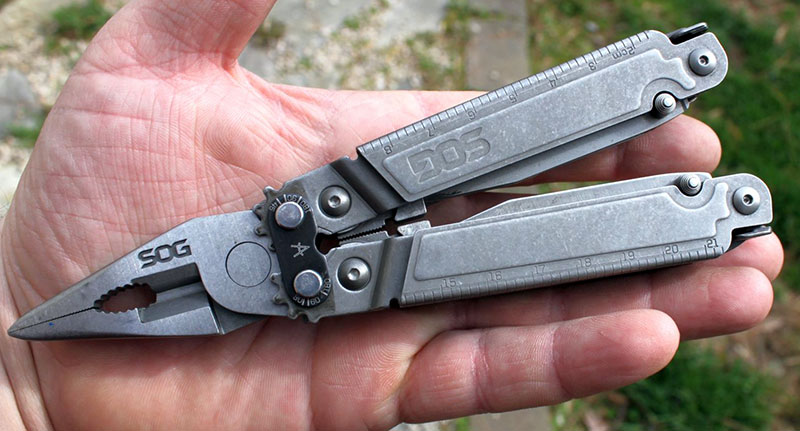
The pliers themselves have a needlenose tip, a plain notched plier section for grabbing nuts, and a wire cutter section at the base, and when the tool is folded up there’s a ¼” hex driver in between the two pivots that has a magnetic retainer feature. There are no replaceable hard-wire cutters like you see on some other high-end large multitools, but the benefit of those is questionable at times anyway. The pliers measure just short of 3” long from the pivots to the tip.
The other primary implements are the four larger outer tools: on one handle, a plain edged blade and a belt cutter/hook cutter, and on the other handle a serrated blade and a wood saw. All four of these implements open up via a thumb stud with assisted opening from a torsion bar that is wedged in between the inner and outer liners, and they all lock in place with a sprung lockback mechanism that spans the entire width of the handle – it’s also the locking mechanism for the secondary implements which we will discuss in the next section. Due to the positioning of the thumb studs, the plain edged blade and the serrated blade are opened right-handed, while the hook cutter and the wood saw are opened left-handed. Hope you’ve brushed up on your ambidextrous skills!
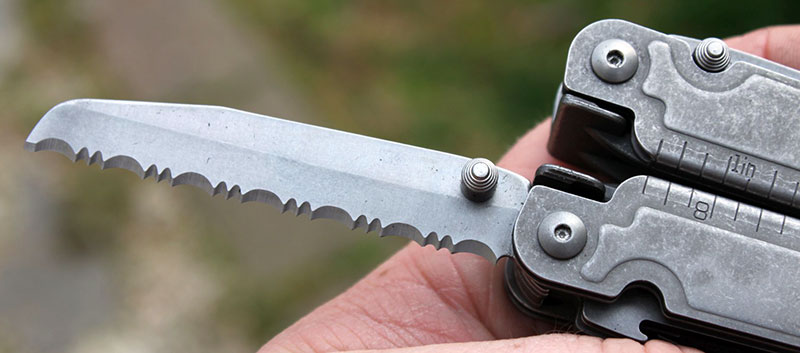
The plain edged blade is saber-ground, with a clip point profile and measuring approximately 2.75″ long from the base to the tip. SOG doesn’t provide a ton of technical measurements in their documents, so my trusty pair of digital calipers measure the blade at 0.082” wide and 0.048” behind the edge. This isn’t a particularly strong ratio of taper from spine to edge, so don’t expect the blade here to be much of a slicer.
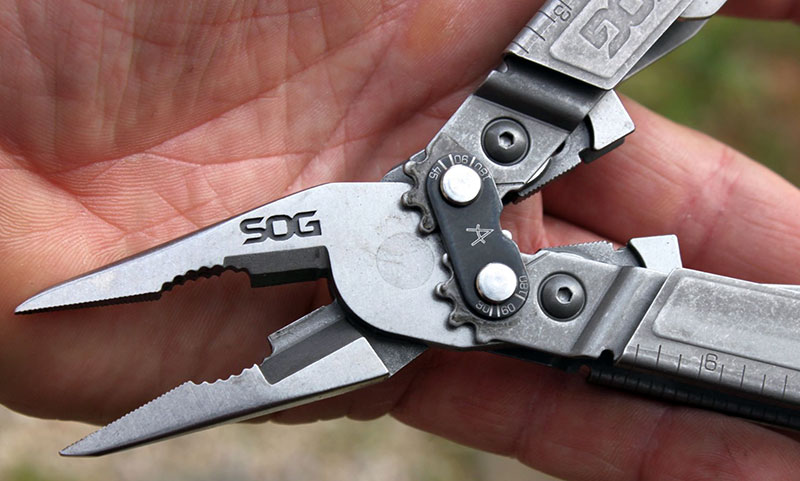
The serrated edge blade also measures 2.75″ from the base to the tip, with a blunt-nosed tip to prevent piercing things. The edge bevel is v-ground but the serrated teeth – in an alternating short/wide pattern – are chisel ground, as most serrations are. Blade stock is similarly thick at 0.08” at the spine. The saw is much thinner blade stock – 0.048” at the spine and just shy of 3” long – and has a hybrid crosscut/ripsaw pattern that works in the pulling direction, with very aggressive teeth. Finally, the hook cutter – which has a single sharpened notch to be used in pull cuts, or on packaging, measures around 2.25″ long.
Secondary Implements
All of the secondary implements on the PowerAccess Assist are situated on the outside of the tool when closed, between the four main spring-assisted large tools. One side contains 4 items, the opposite side 3. The side with 4 includes a can opener with a small straight driver and a sharpened edge for cutting can lids, a 3D Phillips #2, a bottle opener with a medium straight screwdriver at the tip, and what SOG calls a jewelry screwdriver – a long straight with a fine point straight screwdriver at the end.
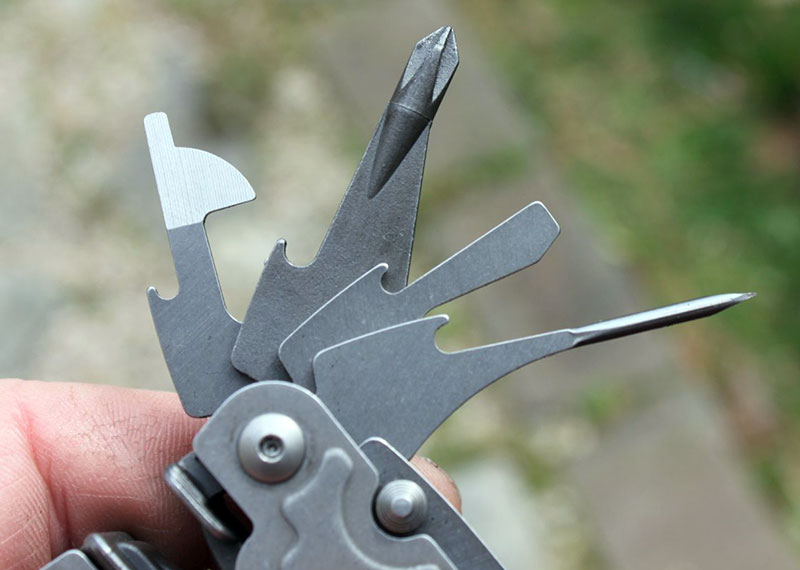
The other side of the handle contains the 3 small tools consisting of a chisel, an awl with a hole for thread, and a ¼” bit driver with an integrated retainer spring that is used with the included bit kit (more on that later.) All of these tools are quite small in size – while its inclusion in a multitool seems almost compulsory, a bottle opener that measures less than 1.5” long seems an odd way to use some space, ditto the 1.25” long chisel – the lengths of all of these tools are restricted by the plier head’s position in the handles when it’s closed.
Features, Fit & Finish
There are two options when it comes to the PowerAccess Assist – a black oxide coating, or this stonewashed silver finish. I always prefer stonewash as it doesn’t show wear and tear nearly to the same extent as a black finish does, but the tools are otherwise identical. The scales are stamped and folded steel, held together by threaded Allen screws – unlike a lot of multitools, which are pinned together and cannot be disassembled without some serious tools. SOG’s multitools have a reputation among online critics as having poor build quality, but that’s not really the case from my admittedly small sample size. The edge grind on the blade is the only thing I can point to as being visibly wonky, but in the company of Leatherman – who have the worst edge grinds of any sharp object – it’s nothing to complain about. The smaller secondary tools are solid. I especially like the finish on the plier head, with its rounded edges and lustrous stonewash, as well as “SOG” engraved on both sides. The typical hallmark of a good plier is here- the tips line up perfect and are totally flush, and there are no burrs or sharp edges where there shouldn’t be.
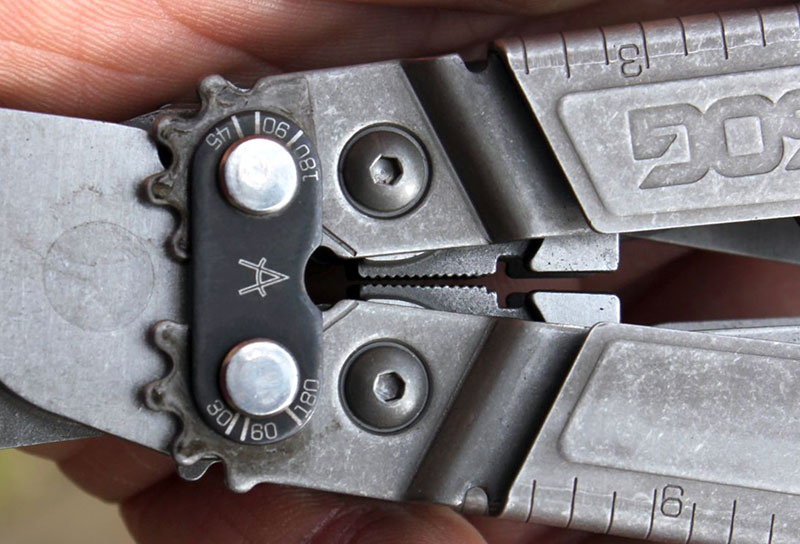
Beyond the tools mentioned in the previous sections, there are a lot of other features included with the PowerAccess Assist. The scales have ruler markings, with inches on one side and centimeters on the other, leaving the space left by the plier head blank and then continuing with the total measurement on the right side – i.e. any measurement between 8.75 and 14.25cm or between 3 3/8” and 5 5/8” isn’t there. Useful, but odd. Ditto the angle gauge that’s on the plier pivot, with demarcations for 30, 45-, 60-, 90-, and 180-degree angles – using markings on the arms to line up with readings on the (fixed) gauge to give you an approximate angle. Considering they only work during the first half of travel when opening the handles, and the tips of the pliers lose contact with your flat surface past 60 degrees, I’m not sure if they’re intended as function or decoration. Not like anything is lost by having them there, just odd.
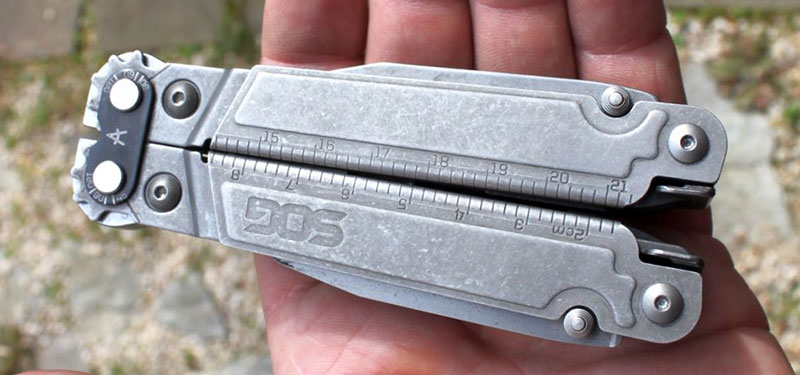
The tool comes with a ballistic nylon sheath as well as a bit kit which fits (with some persuasion) into an elastic loop on the side of the sheath. It is Molle compatible and can be configured to be worn vertically or horizontally with the straps on the back, and uses a long Velcro enclosure to secure it. The bit kit is unusual – it contains 12 bits (Phillips #1,2,3, Flathead #3,5,7, Torx T6/8/10/20, and Hex 1.5 and 2mm) and a quarter-inch driver which has a square input and hex output. All of these bits slot into one side of the carrier, then the other side slides down over the tops. The first time you slide this bit kit into the elastic loop it feels like it won’t fit. It will eventually.
Field Test
There was a lot to get used to carrying this SOG after years of being used to carrying Leatherman. That’s not always a good thing – a learning curve for a tool you use all the time isn’t ideal. Some of the ideas that SOG brought to the table here are very smart, and other ones aren’t so much.
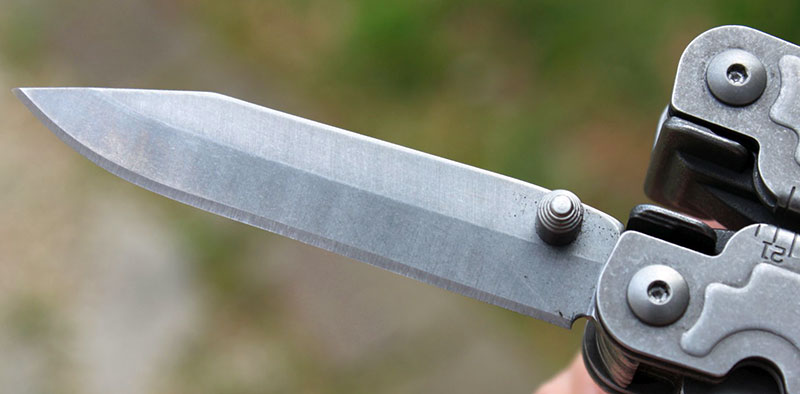
First, carry. This thing is heavy, SOG quoting 10.7 ounces as the product weight. When I first started carrying it for this review, I almost wrote it off entirely due to the sheath. As it comes out of the box, the vertical strap (which is sewn at the top and has a snap to close at the bottom) went under the top horizontal strap and over the bottom strap, then snapped in place. I found that any time the sheath brushed against anything as I walked past, the snap would come undone and the whole tool would fall off onto the ground, which you might recognize as being the opposite of the point of a sheath. After being annoyed by this for longer than I’d care to admit, I figured out you can pull the strap back through, pass it over the top loop and under the bottom loop and then snap it, which prevents the snap from coming undone every time you brush it against anything. I’d feel silly for not realizing this, but more than one review on SOG’s website mentions it as well – hopefully this helps. I tried carrying it horizontally but the loops are too narrow for my belt, and I’m used to vertical anyway. Regardless, this is a very heavy tool and you never forget it’s there on your belt after a long day.

The big talking point of SOG’s tools are the compound leverage pliers, and this is just not a plus for me. Yes, you can apply much more force with the same amount of grip, but I’m not sure when this has ever been the problem with multitools, and it leads to the downside that you have to splay the handles out very wide to get the plier head around most nuts. With non-compound-leverage pliers this is easy to do with one hand, but needing to open the handles twice as wide to grab onto something never stopped feeling awkward to me when I was testing. The upside is that it makes it very easy to cut wire, but I have dedicated tools for that at work which is where I used this SOG the most. Another issue I discovered is that all of the outer locking tools – both knives, the hook cutter and the saw – move around entirely too much both in the open and closed positions, and the saw sometimes moves so much it obstructs the travel of the plier head when it’s opening, and you can’t tighten the pivot screw for the saw down to prevent it from moving – it’s just play in the mechanism.

Another oddity is the bit-driver solution they’ve come up with here. It’s certainly flexible and adaptable – ¼” hex drive bits are extremely common, so you could customize the array of bits with the kit to your liking or needs – but the process of using either of the bit drivers (the integrated one at the tip of the tool when the pliers are closed, as well as the ¼” adapter in the kit) just takes way too many steps and is confusing. Let’s say you want to tighten a Torx T20 screw. First, you open the sheath and pull out the tool, as well as the bit kit. Then you find the ¼” bit adapter driver tool and fold it out. But it has a half-stop, so you unlock it and fold it out another 90 degrees. Then you pull the two halves of the bit kit apart to access the ¼” hex bit adapter in the kit. It is a VERY tight fight, so if you can wiggle it out by hand, do that. If not, unfold the pliers then use them to pull the adapter out, then fold them back up. Now attach the adapter to the driver. Finally, pull your T20 bit out and attach it to the adapter. Now you’re ready to turn a screw.
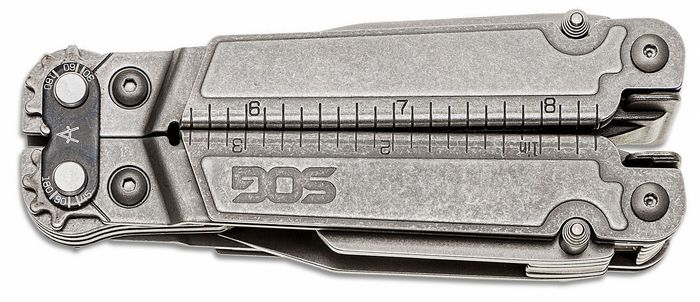
By my counting, that’s 11 steps. If you want to just turn the screw using the integrated bit driver at the end of the tool, you’re only down to 6 steps, but you don’t have nearly as much reach as the adapter does, and you can’t lock it at a 90 degree angle for more torque. Also, while ¼” hex bits are easy to find and replace, there are advantages to Leatherman’s proprietary 2D flat bits: they’re double sided, so their bit kits technically hold 22 different bits (10 double sided bits plus the jeweler’s screwdriver) while being shorter, thinner, and lighter. They’re also less of a headache since the bit kit is single piece, and there’s no adapter to struggle with unless you buy their overpriced extender.
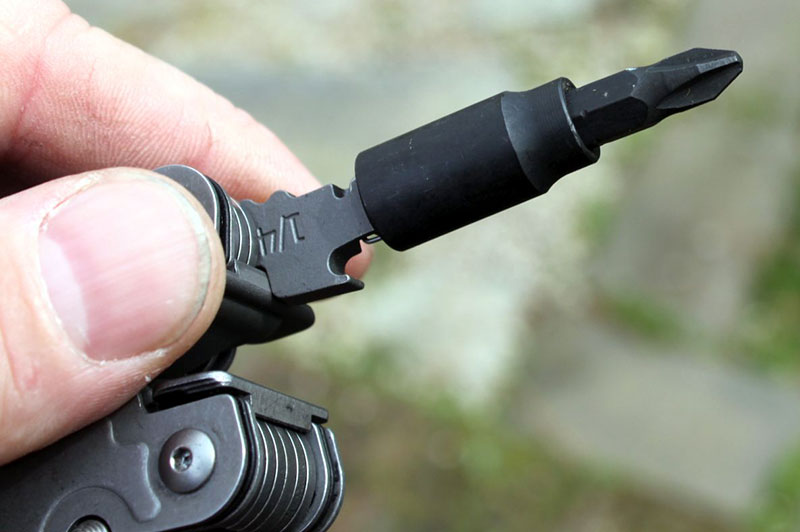
While I’m complaining, I think the assisted opening on the four outermost tools is almost entirely a negative addition to this tool. The assisted opening mechanisms sit in their own separate liners outside of the tool. The whole tool measures 0.882” wide, or 0.625” wide if you’re just measuring the inside liners. This means that assisted opening makes the whole tool an entire quarter inch wider as well as heavier, and I don’t like assisted opening on a pocket knife – I think I like it even less on a multitool. It makes opening the tool faster – which was never the issue – and makes closing it more difficult – which has always been the issue. No one is using their sheath-carry multitool as a tactical fighting knife. The additional difficulty of closing the knife – which requires two hands to do safely – is much more of an inconvenience than any potential benefit from opening faster. Add in some other issues: the tools are hard to open thanks to stiff detents and sharp thumb studs with no room to get your thumb around (they’re flush with the scales), and the force of assisted opening sometimes “clumps” the smaller tools and causes them to pop out at the same time, which also causes the lock to not engage. To me, this should have probably stopped at the prototype phase.
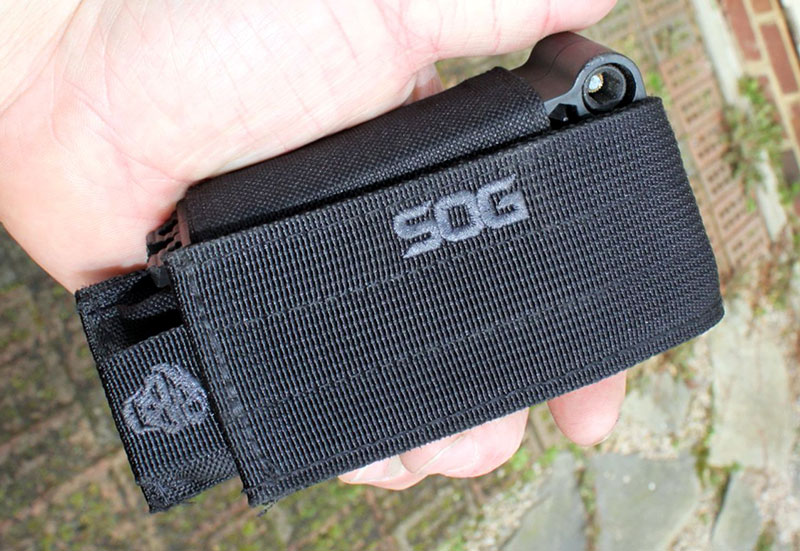
The inner tools are all peculiarly small, especially the bottle opener and the chisel. I do appreciate the long, fine tip straight screwdriver – it’s particularly good for taking key fobs apart to replace the batteries – and the 3D Phillips driver is quite good too, with a decent reach and a good tapered tip that fits a lot of screws. Notable in their absence on this nearly 11-ounce tool are two things: a pair of scissors and a file, both things I’d consider pretty necessary in a large multitool. Perhaps the serrated blade could be replaced with the full-sized folding scissors from the PowerLock models, and a small file could be adapted in place of the one of the inner tools.
So what, you ask, do you like? Well, the hook cutter is absolutely phenomenal at opening up plastic shrink-wrap packaging without damaging what’s inside of it: think those large packs of water bottles, paper towels, that sort of thing. Hook it around an edge of the shrink wrap and the hook cutter works as a zipper. Immensely satisfying. I do like the shape of the pliers, able to pull staples as well as hold nuts from spinning when you’re tightening a bolt. The serrated edge blade is useful at cutting through tough plastic or rope. And once you’ve got the ¼” adapter set up, it functions very well – it has good reach, you can apply a lot of torque with it in the half-stop position, and you can use all sorts of bits. I used the PowerAccess Assist solely to break down an old treadmill, right down to the serrated blade to cut the cords between the platform and body for easier disposal. It’s not even that the tools it has don’t work well, but the standards in this market are high, and for a tool marketed as the “ultimate daily use multi-tool” in the first sentence on SOG’s product page, the omission of a pair of scissors is just baffling.
Alternatives
All these knives available at BladeHQ.
At $100 and weighing in at almost 11 ounces, the PowerAccess Assist is up against the other multitool brand’s large offerings. The Gerber Center-Drive Plus, at $130, is marketed as more of a “tough guy survival tool” (their descriptions says it’s optimized for “weapons maintenance”?) but it’s actually a heck of a lot more useful as a day-to-day carry. While SOG’s tool here is laden with tech wizardry – assisted opening blades, gear driven plier head, hex bit adapter – the Gerber’s namesake – that long, fold-out bit driver – just smokes everything else on the market when it comes to functioning as a screwdriver. Heck, I have screwdrivers I like less than the Center-Drive. Tasks you could not complete with the PowerAccess Assist – like tightening up the retaining screws on a loose doorknob – are done with ease with the Center Drive. It also has a sprung plier head, replaceable (if fragile) hard-wire cutters, slide out one-hand deployment, a longer blade, oh – and a pair of scissors and a file. I’ll give the nod to SOG’s nylon sheath over the Center Drive’s shiny, too-big leather sheath, but a rocket science degree isn’t required to figure out how to use it either. It’s lighter than the SOG, too: 9.7 ounces isn’t featherweight, but it’s still less noticeable after a long day, considering it’s about the same size: 4.7” closed, 6.6” open (compared to the SOG’s 4.5”/6.8”). it also has a half-inch longer main blade that’s half-serrated. It’s $30 more expensive at $130 MSRP.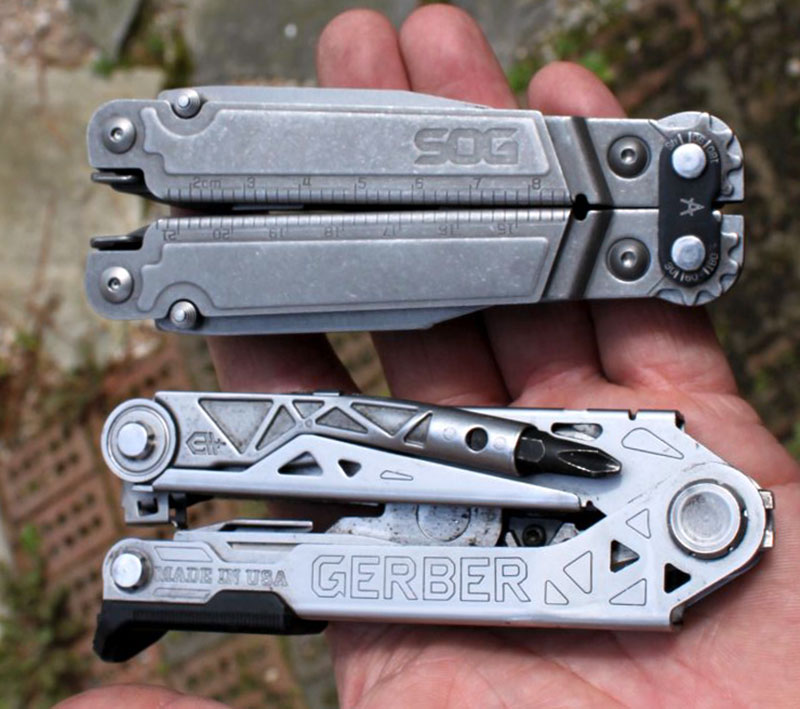
If you prefer a smaller, butterfly-style opening tool like the PowerAccess, the Gerber Suspension NXT also offers a lot of functionality for very little money – $39 currently. It has a sprung plier head, a small pair of scissors and a file, and a bunch of screwdrivers and can/bottle opens, in a 6.7 ounce package. The Suspension lacks the SOG’s bit drivers, but with the leftover cash you could get a dedicated EDC bit driver, like the Fix It Stix 16-bit multitool driver set for $40, and have $20 left over for a nice lunch.
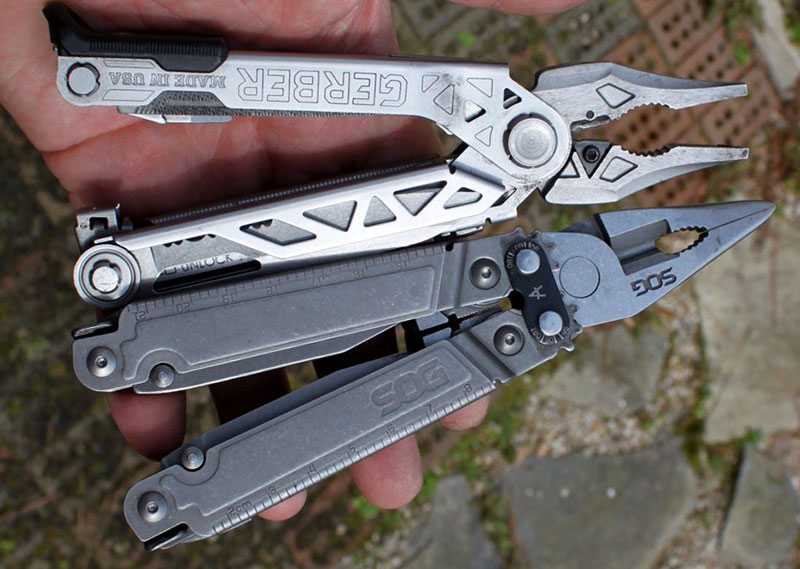
If you want a Leatherman, it’s probably the Wave+ – which you may have heard of before. As Leatherman’s most well-known model, the Wave+ is everything to everyone. At $109 MSRP it’s priced similarly, and it has a little smaller footprint – 4″ closed, 6.25” open, 8.5 ounces. Part of the reason it works better is that the secondary implements are situated inside and the primary ones are outside, rather than them all being on the outside layer like the SOG, so they can be a little larger. This means a longer (2.9”) blade, thinner handles (0.7” wide), and better ergonomics. The bit driver uses the aforementioned proprietary two-sided flat bits, which have their pluses and minuses, but like the SOG, all of the tools lock in place, the outside blades using liner locks and the inner tools using a shared lockback. The Wave+ now features replaceable hard wire cutters, and both the plain and serrated blades are one-hand opening (the saw and file are not) – oh, and it has scissors and a dual-grit file, too. It’s popular for a reason.

Finally, don’t forgot about Victorinox: their new Swiss Tool Spirit MX is the first update to the much-loved line in many years, offering a new one-hand opening thumb tab for the main blade. It’s expensive: $162, but worth it – arguably the highest quality multitool on the market in terms of fit and finish, the stainless handles with their curved ergonomic grips are a delight to use. It doesn’t have a bit driver either, but it does offer a dedicated 3D Phillips as well as several different size straight screw drivers, plus scissors and a file.
Wrap-Up
The phrase that came to mind during my review of the PowerAccess Assist was a portmanteau of two common ideas: it’s a Tour de Force to Nowhere. There are so many advanced technological features to this tool, and they’re all interesting, and none of them actually make the tool work better. Assisted opening on four different blades that just add girth and weight. Compound leverage to apply more force that makes the pliers awkward to use. Two different hex bit drive adapters that are Rube Goldberg-esque in their execution. Lots of tiny implements of questionable utility. I don’t particularly like the PowerAccess Assist, and I don’t think you will either if you care about how your Multi-Tools actually function. Sorry SOG, this one’s not for me.
- Pretty nice fit and finish, well finished and precise plier head, lots of features, lots of technical wizardry, good jeweler’s screwdriver and integrated Phillips driver, flexible carry options, takes standard ¼” hex bits
- Assisted openers make everything worse, makes the tool wider and heavier than it needs to be with very little benefit, hard to open and even harder to close blades, compound leverage plier head is awkward to use, saw blade hits plier head when deploying, convoluted and difficult to use bit drivers, trial-size secondary implements, odd toolset (no scissors or file in an everyday use tool?), extremely heavy, confusing sheath with velcro closure like an 80’s wallet, awkward two-piece bit kit setup
SOG PowerAccess Assist
Quality/Performance - 63%
Value for Money - 67%
65%
“Your scientists were so preoccupied with whether they could, that they didn’t stop to think if they should.” The PowerAccess Assist seems half-baked, which is unfortunate when it’s direct competitor is the best designed and most-recognizable multitool ever made.





